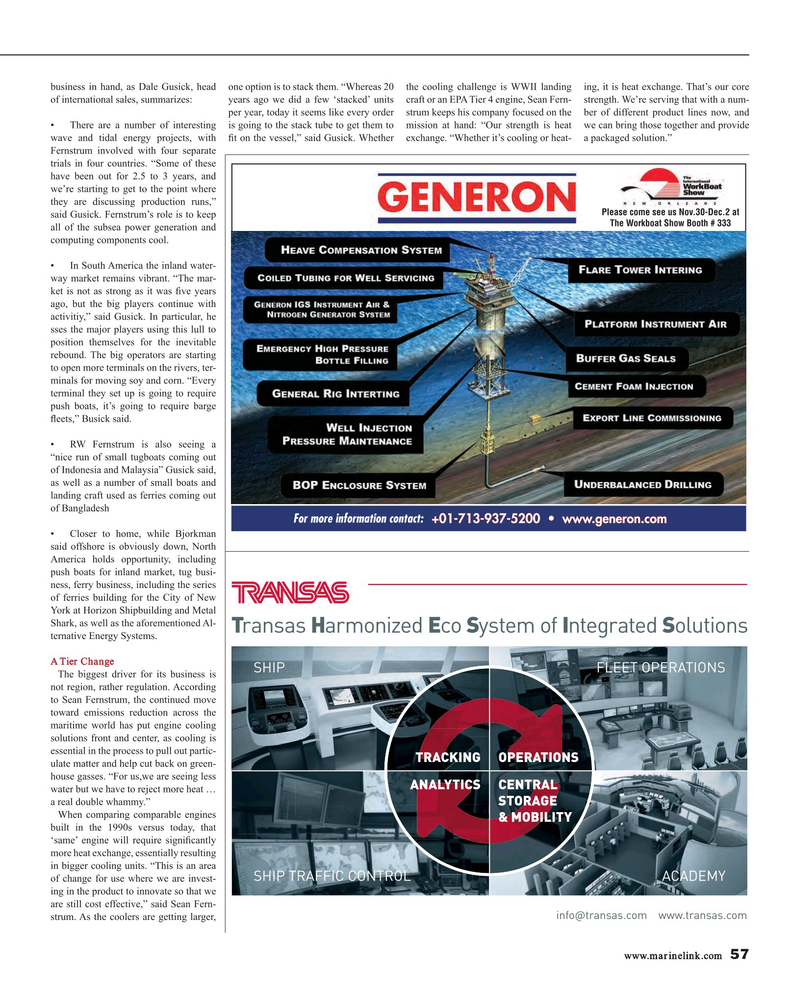
Page 57: of Maritime Reporter Magazine (November 2016)
Workboat Edition
Read this page in Pdf, Flash or Html5 edition of November 2016 Maritime Reporter Magazine
business in hand, as Dale Gusick, head one option is to stack them. “Whereas 20 the cooling challenge is WWII landing ing, it is heat exchange. That’s our core of international sales, summarizes: years ago we did a few ‘stacked’ units craft or an EPA Tier 4 engine, Sean Fern- strength. We’re serving that with a num- per year, today it seems like every order strum keeps his company focused on the ber of different product lines now, and • There are a number of interesting is going to the stack tube to get them to mission at hand: “Our strength is heat we can bring those together and provide wave and tidal energy projects, with ? t on the vessel,” said Gusick. Whether exchange. “Whether it’s cooling or heat- a packaged solution.”
Fernstrum involved with four separate trials in four countries. “Some of these have been out for 2.5 to 3 years, and we’re starting to get to the point where they are discussing production runs,”
Please come see us Nov.30-Dec.2 at said Gusick. Fernstrum’s role is to keep
The Workboat Show Booth # 333 all of the subsea power generation and computing components cool.
• In South America the inland water- way market remains vibrant. “The mar- ket is not as strong as it was ? ve years ago, but the big players continue with activitiy,” said Gusick. In particular, he sses the major players using this lull to position themselves for the inevitable rebound. The big operators are starting to open more terminals on the rivers, ter- minals for moving soy and corn. “Every terminal they set up is going to require push boats, it’s going to require barge ? eets,” Busick said. • RW Fernstrum is also seeing a “nice run of small tugboats coming out of Indonesia and Malaysia” Gusick said, as well as a number of small boats and landing craft used as ferries coming out of Bangladesh
For more information contact: ³ä£?Ç£Î??ÎÇ?xÓääÊÊUÊÊÜÜÜ°}i?iÀ??°V??
• Closer to home, while Bjorkman said offshore is obviously down, North
America holds opportunity, including push boats for inland market, tug busi- ness, ferry business, including the series of ferries building for the City of New
York at Horizon Shipbuilding and Metal
Shark, as well as the aforementioned Al- ternative Energy Systems.
A Tier Change
The biggest driver for its business is not region, rather regulation. According to Sean Fernstrum, the continued move toward emissions reduction across the maritime world has put engine cooling solutions front and center, as cooling is essential in the process to pull out partic- ulate matter and help cut back on green- house gasses. “For us,we are seeing less water but we have to reject more heat … a real double whammy.”
When comparing comparable engines built in the 1990s versus today, that ‘same’ engine will require signi? cantly more heat exchange, essentially resulting in bigger cooling units. “This is an area of change for use where we are invest- ing in the product to innovate so that we are still cost effective,” said Sean Fern- strum. As the coolers are getting larger, www.marinelink.com 57
MR #11 (50-57).indd 57 11/4/2016 9:26:51 AM

 56
56

 58
58
